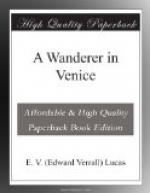At the south of the campo is the Campiello Querini where we find the Palazzo Querini Stampalia, a seventeenth-century mansion, now the property of the city, which contains a library and a picture gallery. Among the older pictures which I recall are a Holy Family by Lorenzo di Credi in Room III and a Martyrdom of San Sebastian by Annibale Caracci in Room IV. A Judith boldly labelled Giorgione is not good. But although no very wonderful work of art is here, the house should be visited for its scenes of Venetian life, which bring the Venice of the past very vividly before one. Here you may see the famous struggles between the two factions of gondoliers, the Castellani and the Nicolotti, actually in progress on one of the bridges; the departure of the Bucintoro with the Doge on board to wed the Adriatic; the wedding ceremony off S. Niccolo; the marriage of a noble lady at the Salute; a bull-fight on the steps of the Rialto bridge; another in the courtyard of the Ducal Palace; a third in the Piazza of S. Mark in 1741; the game of pallone (now played in Venice no more) in the open space before the Gesuiti; fairs in the Piazzetta; church festivals and regattas. The paintings being contemporary, these records are of great value in ascertaining costumes, architecture, and so forth.
I speak elsewhere of the Palazzo Giovanelli as being an excellent destination to give one’s gondolier when in doubt. After leaving it, with Giorgione’s landscape still glowing in the memory, there are worse courses to take than to tell the poppe to row on up the Rio di Noale to the Misericordia, in which Tintoretto painted his “Paradiso”. This great church, once the chief funeral church of Venice, is now a warehouse, lumber rooms, workshops. Beside it is the head-quarters of the pompes funebres, wherein a jovial fellow in blue linen was singing as I passed.
At the back of the Misericordia is an ancient abbey, now also secularized, with a very charming doorway surmounted by a pretty relief of cherubs. Farther north is the Sacco of the Misericordia opening into the lagoon. Here are stored the great rafts of timber that come down the rivers from the distant hill-country, and now and then you may see one of the huts in which the lumber-men live on the voyage.
From the Misericordia it is a short distance to the Fondamenta dei Mori, at No. 3399 of which is the Casa di Tintoretto, with a relief of the great painter’s head upon it. Here he lived and died. The curious carved figures on this and the neighbouring house are thought to represent Morean merchants who once congregated here. Turning up the Campo dei Mori we come to the great church of the Madonna dell’Orto, where Tintoretto was buried. It should be visited in the late afternoon, because the principal reason for seeing it is Tintoretto’s “Presentation,” and this lovely picture hangs in a dark chapel which obtains no light until the sinking sun penetrates its window and falls on the canvas. To my mind it




